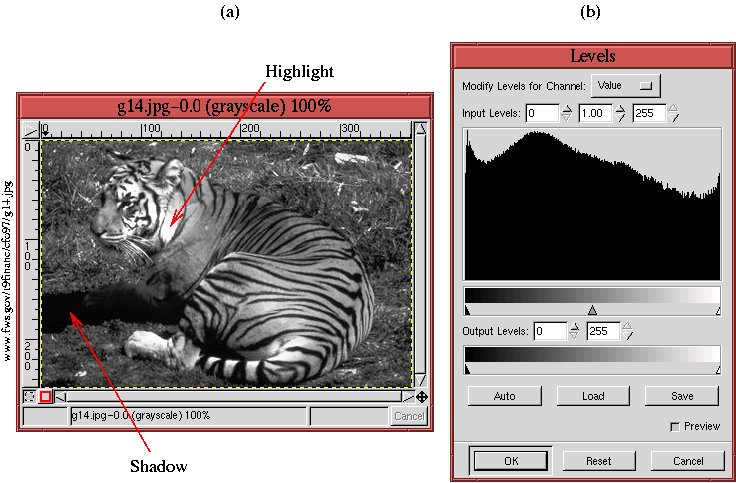Subsections
6.1 Improving Tonal Range
Improving the tonal range of an image is the first step that should be
taken in almost every effort to touch up and enhance a photo.
To do this, it is necessary to understand the basic elements
of tonal range and the tools the GIMP provides to measure and
affect it.
6.1.1 Highlights and Shadows
What is tonal range? To answer this question, let's look at the
grayscale photo shown in Figure
6.1(a).
Figure 6.1:
Highlights and Shadows in a Grayscale Image
 |
The figure shows a tiger image consisting of a complete range of
grayscale values from 0, or completely black, to 255, fully white.
Furthermore, from the histogram
shown
in Figure
6.1(b), you can see that the
distribution of pixel values in the image smoothly covers the entire
available range. The histogram shown in
Figure
6.1(b) is part of the
Levels tool,
which is discussed in detail in the next section.
The lightest part of an image is called the highlight and the
darkest is called the shadow. It is important to note that not
all images will have the maximum highlight of 255 and/or the minimum
shadow of 0. Thus, the tonal range of an image is just the numeric
difference between the image's maximum highlight and its minimum
shadow. You will see shortly that measuring highlight and shadow
values is useful for performing image enhancement, but before
developing this idea, let's examine why tonal range is so important.
Having a full tonal range is generally a good thing. A full tonal
range means that the image has, in a general sense, the fullest
possible contrast. To illustrate this idea, the tonal range of the
image in Figure
6.1(a) can be synthetically
diminished by setting the output sliders of the Levels tool to
values well inside the range of 0 to 255. This adjustment is shown
Figure
6.2(b),
Figure 6.2:
Limited Tonal Range
 |
and the result on the image is shown in
Figure
6.2(c). Here, you can see the effect of
compressing the tonal range. Figure
6.2(b)
shows the settings of the
Levels tool used to limit the tonal
range. Notice that the resulting contrast of the image in
Figure
6.2(c) is much poorer than the contrast
in Figure
6.2(a). The image with the smaller
tonal range looks muddy and washed out in comparison to the original.
This example is based on a grayscale image whose tonal range has been
synthetically impoverished. Nevertheless, the conclusions that can be
drawn from it are general. That is, maximizing tonal range is usually
a great way to enhance an image. However, sometimes it is better not
to maximize the tonal range. An image of white lace gloves on a white
linen tablecloth background is such an example. Under these
circumstances, there is a subtle interplay of whites and off-whites in
the image, and a deep black shadow is most likely undesirable. In
most cases, however, getting the most tonal range out of an image
improves contrast, which in turn significantly enhances the image.
